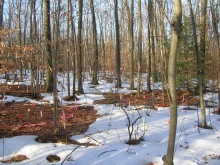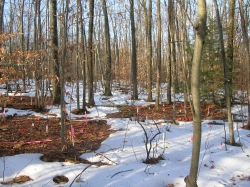You are here
Results from a 20-Year Soil Warming Experiment

New research out of the Harvard Forest, published today in Nature Climate Change, sheds new light on the unexpected ways soil microbes respond to climate change. According to the study, led by U. of New Hampshire scientist Serita Frey: as temperatures rise, soil microorganisms release more carbon dioxide into the atmosphere, creating a feedback loop that could exacerbate climate change in the future. Luckily, these effects diminish over time.
- Read the Mother Jones article: With Warming, Soil Releases More CO2... Though Less Over Time as Microbes Adapt.
- Read the Harvard Forest press release.
- Download the original Nature Climate Change research paper.
- Watch a video on Frey's work at the Forest.
- Learn more about the soil warming LTER experiment.
Photographs
Serita Frey collects soil samples with UMass-Amherst graduate student George Hamaoui. Photo by Brian Godbois.
A soil sample is collected for analysis. Photo by Serita Frey.
 Long-term soil warming plots at the Harvard Forest. The photo was taken in the midst of a January thaw. Temperatures that day were around 50 Farenheit, and the heated plots, which had been snow covered for about six weeks, had melted before the unheated ones. Photo by Alix Contasta.
Long-term soil warming plots at the Harvard Forest. The photo was taken in the midst of a January thaw. Temperatures that day were around 50 Farenheit, and the heated plots, which had been snow covered for about six weeks, had melted before the unheated ones. Photo by Alix Contasta.

